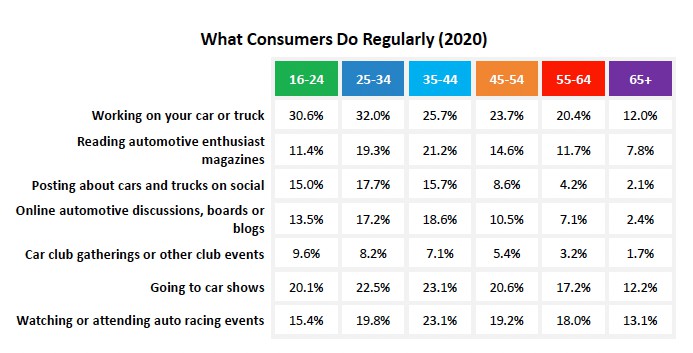Ah. those misconceptions…
Believe it or not, we learn on page 55 of the recently published SEMA Future Trends study, “there are more licensed drivers under the age of 25 today than there were two decades ago.”
Say what?
“There’s another misconception that young people no longer drive,” the study’s authors report a few pages later.
“While license rates are certainly down for those under age 25, there are over one million more drivers in this age group than there were in 1999. There are many factors that contribute to this, including higher costs for insurance and vehicles. However, the fact of the matter is that license rates are down across the board for every age group except for those 55–64 or 65+.
“One shift that has happened is that there are more older drivers today than there were back in 1999. This is a natural byproduct of an aging population. Despite this growth of older drivers, it is not translating to more accessorization — underscoring that young people do care about cars and are critical to the specialty-equipment industry.”
So while the study notes that the largest driving demographic is the 46.3 million drivers 65 or older, the next-largest are the 40.3 million between 25 and 34, and there are 26.2 million between 16 and 24.

And if you think any of those statistics are interesting, what until you read what comes next:
“Phones are less important than a car as consumers get older,” is the headline on page 63.
“Americans tend to age into their vehicles, as priorities shift in life,” the study reports. “As a teenager, the car can seem less important than the phone they have relied on for years. However, that quickly changes by the time someone enters their 20s. As people age and take on new responsibilities and commute to a job or school, their car becomes more important.
“It’s not that young people don’t care about their car, it’s just that they have different habits and priorities — which quickly change as they get a little older.”
While only 47 percent of those 19-24 said they’d rather go a week without my phone than my car, the number of those 25-34 so responding was 57 percent. OK, so of those 55 and older, more than 60 percent picked their cars over their phones, the point is that people change as they age.
And get this: Attendance at car shows, car clubs and auto racing, and in online automotive discussions, and even on working on their vehicles, is higher on a percentage basis for those 16-24 and 25-34 than it is for those 55 and older.
So, are you still worried about the future of the car collecting hobby?

The study was conducted for SEMA members, people who produce or sell aftermarket automotive parts and equipment. And they are informed that nearly 70 percent of such equipment purchased in 2020 was purchased by those under the age of 40.
“Despite popular misconceptions, many young people do care about their vehicles and are accessorizing.”
And spending on such parts are up overall. For one thing, the pandemic kept people at home and looking for things to do, such as working on their vehicles. Plus, they had stimulus checks they could spend. Finally venturing out in the third quarter of 2021, “retail sales were up 24 percent, motor vehicle and parts spending was up 27 percent, and discretionary spending was up 5 percent all versus pre-pandemic.”
FYI: SEMA sees continuing if slower growth in the market in 2002, with a likely return to “normal” in 2023.





